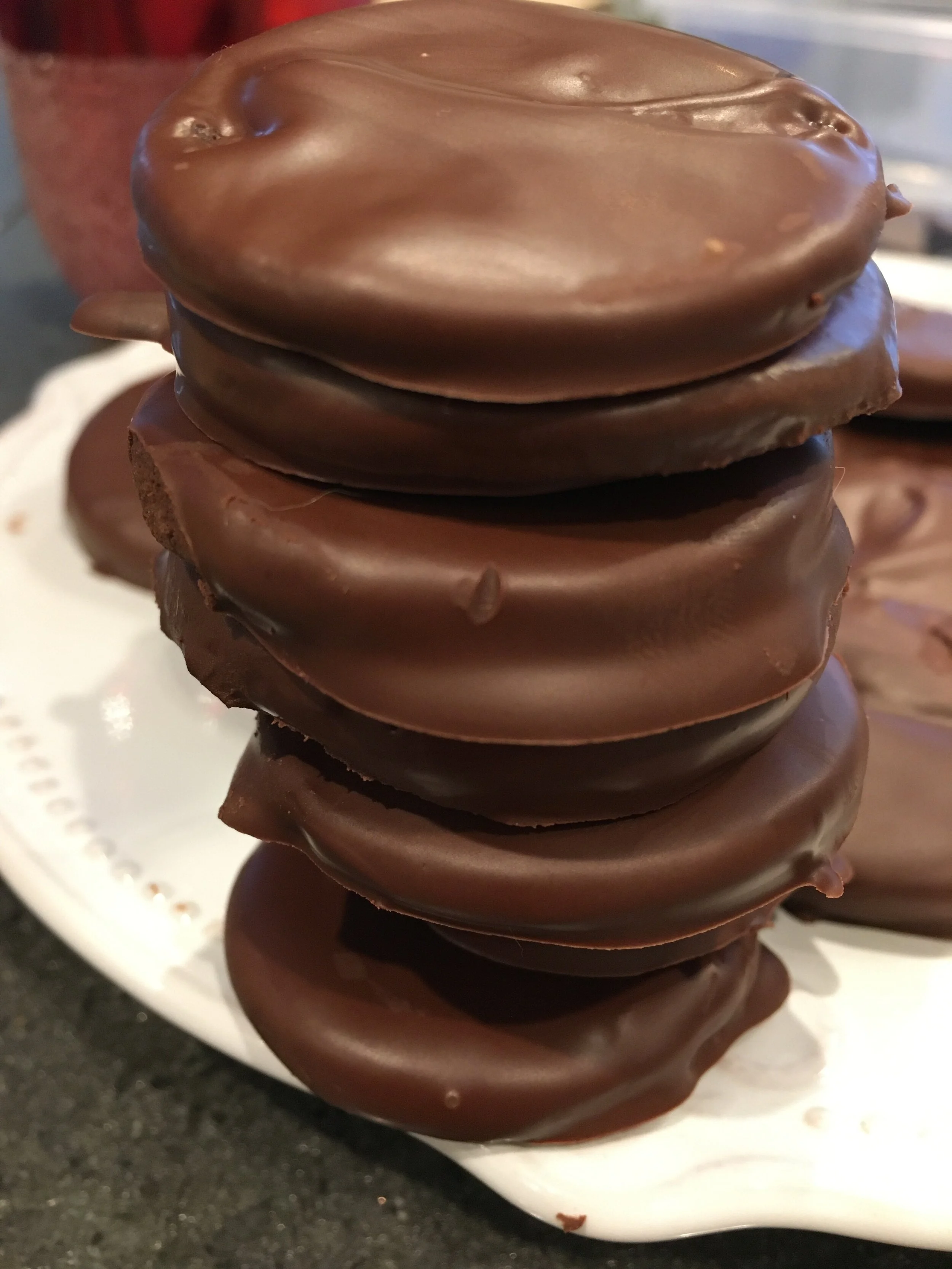Real Food Goldfish Crackers
This recipe was a long time coming! In fact, It’s been sitting among a list of other “need to write now” blog posts but always ended up falling aside. Until I recently saw an instagram post from Vani Hari (The food babe) where she dove deep into the unpleasant (dare i say toxic?) ingredient list in Pepperidge Farm Goldfish Crackers. Yep, it’s filled with enriched flours, yeast extracts, and genetically engineered additives so this was not a surprise to me as I now just assume these ingredients are sadly in most processed foods. This is why it’s been a mission to make my own.
Recipe testing is partially what I do for a living so by no means do I expect parents with full time jobs outside their kitchen to have homemade foods available all the time. But if I could provide some options for when they could fit it in, I’m here for them!
I always say there are good...better...best options when it comes to eating, with the cheaper processed foods representing the worst, organic (but still processed foods) being better, and your own homemade goods being best.
The case for providing real-food to kids: Do we even need to make a case?
I have talked in my blogs, on social media, and directly to my clients about my loathing for the so-called foods available in most stores today. I feel (and science has validated) that our food system is a major reason for the spike in autoimmune, digestive, cardiovascular, and gut-related disorders among our population as well as our mental health. I firmly believe that every issue (yes even the political ones) can be solved if we began by changing our food system. From socioeconomics, to mental health, and of course health care. This would of course come with a lot of education and work since it would mean a breaking down of the current industrial complexes that currently exist including farming, agriculture, media, and all the way up to the pharmaceutical industry. To be clear, those involved in these industries are usually people with good intentions just trying to do their jobs.
But, there goes the saying...
“It is difficult to get a man to understand something, when his salary depends on his not understanding it.” Upton Sinclair
Let’s just say it’s easier to have a commercial that says “Cheerios lowers cholesterol” followed by an ad for cholesterol medication Vs something that actually supports the root cause of our deteriorating health. $$$$
When was the last time you saw an ad for vitamin D or broccoli?
Ok, enough of my rant, let’s break down the science on the Goldfish.
Food dyes and other chemicals
According to the CDC (center for disease control), prevalence of autism has skyrocketed to 1 in 59 children in 2018 and creeping up to higher numbers. Research from the last decade has linked artificial food dyes including Blue 1 and 2, Green 3, Red 3, Yellow 5 and 6, Citrus Red 2, and Red 40 to harmful effects in children. Symptoms can include hyperactivity, sleep disturbances, OCD-like tendencies, and other behavioral issues. Autistic children are especially susceptible to environmental triggers, now when we add on the byproducts that consist of formaldehyde, aniline, hydroxides, and sulfuric acids, where heavy metals (lead, arsenic, and mercury) can also be present, we create an uphill cascade as the body attempts to detoxify. Through the study of epigenetics (gene function and its relationship to our environment and lifestyle), we know that some people (including children) don’t have the necessary gear to effectively rid the body of exogenous toxins in a timely manner which provides a breeding ground for intestinal impermeability, immune system decline, nutrient deficiencies, and potential neurological conditions. Bottom line...autistic or not...they’re no good for the body.
Industrialized “Plant oils”
Soybean, canola (rapeseed), vegetable, peanut, cottonseed, safflower, etc oils are still being promoted as “healthy” on many government “health” websites despite the research that says they’re flat out...not. In fact, these oils are often very delicate, that means they oxidize when heated (if they’re not already). This causes an inflammatory state in the body as it attempts to make sense of what’s happening. We are much better off with foods the body recognizes. Obviously olive oil is wonderful though we can’t heat it to a high temperature or it too takes on a “trans fat” state. Much better to stick with refined avocado oil, ghee, or butter for higher temperatures, ghee, and coconut oil for medium heat, and save the nut oils and olive oils for room temp or drizzled on at the end of cooking. Our friends at the Goldfish company apparently didn’t get this memo and they are not alone.
Here’s the thing….at a cellular level, we are only as good as our cell membranes. They dictate what’s coming in and going out of our body (from the very toxic to the very nutritious), and diet has become increasingly important especially for our newest generations who have been brought up in a world of processed sugars, chemicals, and industrialized fats.
What kind of oil are restaurants and processed food companies using?
I often tell my clients to always assume when we eat out or purchase ready-to-go foods that due to cost reasons, these restaurants and food companies are not using avocado oil, ghee, or coconut oil to cook . As an example, oils that are repeatedly used for deep frying go through a series of changes in chemical composition and physical characteristics. The combination of cheaper “plant-based” vegetable, corn, canola, peanut, soybean, etc oils and higher temperatures (above 180 degrees) makes for a lethal combination, especially when done on a regular basis as it yields unrecognizable end products including volatile compounds, hydrolysis products, oxidized triacylglycerol monomers, cyclic compounds, trans configuration compounds, polymers, sterol derivatives, nitrogen- and sulphur-containing heterocyclic compounds, acrylamide, etc” (Zhang 2012). These end products are then found in the cooking oil as well as the food.
Canola oil (rapeseed) alone has been linked to vitamin E deficiency and shortened life span in animal studies, and represents one of the most heavily industrialized, GMO crops (more on this below).
This is the oil that’s baked into Goldfish crackers.
Glyphosate and GMO’s
Glyphosate (N-(phosphonomethyl) glycine) is one of the most commonly used herbicides in our world today and is used in farming methods in the United states and beyond. Research is continuing to pour in on its effects on human health and our environment.
For more info on glyphosate, read my post What is glyphosate and how can I avoid it? Here.
And Vani Hari has compiled a great list of the top snack foods to avoid for their level of glyphosate.
Real-Food Goldfish Crackers
1 cup organic whole wheat pastry flour (GF use paleo flour)
1/2-3/4½tsp sea salt
1/2½stick grass fed butter, chilled and a bit softened (not melted)
1 cup +2 Tbsp sharp cheddar organic or grass-fed cheese ( i.e.Kerry Gold)
Few Tbsp water
Preheat oven to 350
In small bowl combine flour and salt. Set aside. In food processor, add butter and cheese and pulse until combined. Then add dry ingredients slowly and pulse a few more times. Form ingredients into a ball, adding small amounts of water as needed.
Wrap and chill about 30 min in fridge. Roll out about 1/4 inch thick (or as thin as you want). The thinner you go generally the more crunch you’ll have but check the oven frequently to avoid burning.
Bake 12-15 min (depending on thickness)
You will also love these other nourishing treats!
Disclaimer: This post includes affiliate links and products sold on this site including but not limited to nutritional supplements, ebooks, programs etc. which generate a tiny profit as the primary income of my blog at no additional cost to you. The greatest wealth is health so thanks for contributing!
References
Bakthavachalu, P., Kannan, S. M., & Qoronfleh, M. W. (2020). Food Color and Autism: A Meta-Analysis. Advances in neurobiology, 24, 481–504. https://doi.org/10.1007/978-3-030-30402-7_15
https://foodbabe.com/over-100-snacks-better-than-goldfish-for-kids/
Weinhold B. (2006). Epigenetics: the science of change. Environmental health perspectives, 114(3), A160–A167. https://doi.org/10.1289/ehp.114-a160
Flores-Álvarez, M., Molina-Hernández, E. F., Hernández-Raya, J. C., & Sosa-Morales, M. E. (2012). The effect of food type (fish nuggets or French fries) on oil blend degradation during repeated frying. Journal of food science, 77(11), C1136–C1143. https://doi.org/10.1111/j.1750-3841.2012.02930.
Sauer, F. D., Farnworth, E. R., Bélanger, J. M. R., Kramer, J. K. G., & Yamashiro, S. (1997). Additional vitamin E required in milk replacer diets that contain canola oil. Nutrition Research , 17(2), 259–269.
Zhang, Q., Saleh, A. S., Chen, J., & Shen, Q. (2012). Chemical alterations taken place during deep-fat frying based on certain reaction products: a review. Chemistry and physics of lipids, 165(6), 662–681. https://doi.org/10.1016/j.chemphyslip.2012.07.002
Medicines & vegetable oils hidden cause of disease
https://www.karger.com/Article/Fulltext/446704
Glyphosate, The root cause of inflammation, Zach Bush M.D.








